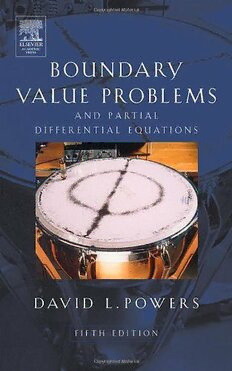
Boundary value problems and partial differential equations PDF
Preview Boundary value problems and partial differential equations
B O U N D A R Y VALUE PROBLEMS FIFTH EDITION This page intentionally left blank B O U N D A R Y VALUE PROBLEMS ANDPARTIALDIFFERENTIALEQUATIONS DAVID L. POWERS C l a r k s o n U n i v e r s i t y FIFTH EDITION Amsterdam Boston Heidelberg London NewYork Oxford Paris SanDiego SanFrancisco Singapore Sydney Tokyo AcquisitionsEditor TomSinger ProjectManager JeffFreeland MarketingManager LindaBeattie CoverDesign EricDeCicco InteriorPrinter TheMapleVailBookManufacturingGroup ElsevierAcademicPress 30CorporateDrive,Suite400,Burlington,MA01803,USA 525BStreet,Suite1900,SanDiego,California92101-4495,USA 84Theobald’sRoad,LondonWC1X8RR,UK Thisbookisprintedonacid-freepaper.(cid:1)∞ Copyright©2006,ElsevierInc.Allrightsreserved. Nopartofthispublicationmaybereproducedortransmittedinanyformorbyany means,electronicormechanical,includingphotocopy,recording,oranyinformation storageandretrievalsystem,withoutpermissioninwritingfromthepublisher. Permissions may be sought directly from Elsevier’s Science & Technology Rights Department in Oxford, UK: phone: (+44) 1865 843830, fax: (+44) 1865 853333, e-mail: [email protected]. You may also complete your request on-line via the Elsevier homepage (http://elsevier.com), by selecting “Customer Support” and then“ObtainingPermissions.” LibraryofCongressCataloging-in-PublicationData Applicationsubmitted BritishLibraryCataloguinginPublicationData AcataloguerecordforthisbookisavailablefromtheBritishLibrary ISBN13:978-0-12-563738-1 ISBN10:0-12-563738-1 ForallinformationonallElsevierAcademicPresspublications visitourWebsiteatwww.books.elsevier.com PrintedintheUnitedStatesofAmerica 05 06 07 08 09 10 9 8 7 6 5 4 3 2 1 Contents Preface ix CHAPTER0 OrdinaryDifferentialEquations 1 0.1 HomogeneousLinearEquations 1 0.2 NonhomogeneousLinearEquations 14 0.3 BoundaryValueProblems 26 0.4 SingularBoundaryValueProblems 38 0.5 Green’sFunctions 43 ChapterReview 51 MiscellaneousExercises 51 CHAPTER1 FourierSeriesandIntegrals 59 1.1 PeriodicFunctionsandFourierSeries 59 1.2 ArbitraryPeriodandHalf-RangeExpansions 64 1.3 ConvergenceofFourierSeries 73 1.4 UniformConvergence 79 1.5 OperationsonFourierSeries 85 1.6 MeanErrorandConvergenceinMean 90 1.7 ProofofConvergence 95 1.8 NumericalDeterminationofFourierCoefficients 100 1.9 FourierIntegral 106 1.10 ComplexMethods 113 1.11 ApplicationsofFourierSeriesandIntegrals 117 1.12 CommentsandReferences 124 ChapterReview 125 MiscellaneousExercises 125 v vi Contents CHAPTER2 TheHeatEquation 135 2.1 DerivationandBoundaryConditions 135 2.2 Steady-StateTemperatures 143 2.3 Example:FixedEndTemperatures 149 2.4 Example:InsulatedBar 157 2.5 Example:DifferentBoundaryConditions 163 2.6 Example:Convection 170 2.7 Sturm–LiouvilleProblems 175 2.8 ExpansioninSeriesofEigenfunctions 181 2.9 GeneralitiesontheHeatConductionProblem 184 2.10 Semi-InfiniteRod 188 2.11 InfiniteRod 193 2.12 TheErrorFunction 199 2.13 CommentsandReferences 204 ChapterReview 206 MiscellaneousExercises 206 CHAPTER3 TheWaveEquation 215 3.1 TheVibratingString 215 3.2 SolutionoftheVibratingStringProblem 218 3.3 d’Alembert’sSolution 227 3.4 One-DimensionalWaveEquation:Generalities 233 3.5 EstimationofEigenvalues 236 3.6 WaveEquationinUnboundedRegions 239 3.7 CommentsandReferences 246 ChapterReview 247 MiscellaneousExercises 247 CHAPTER4 ThePotentialEquation 255 4.1 PotentialEquation 255 4.2 PotentialinaRectangle 259 4.3 FurtherExamplesforaRectangle 264 4.4 PotentialinUnboundedRegions 270 4.5 PotentialinaDisk 275 4.6 ClassificationandLimitations 280 4.7 CommentsandReferences 283 ChapterReview 285 MiscellaneousExercises 285 CHAPTER5 HigherDimensionsandOtherCoordinates 295 5.1 Two-DimensionalWaveEquation:Derivation 295 5.2 Three-DimensionalHeatEquation 298 5.3 Two-DimensionalHeatEquation:Solution 303 Contents vii 5.4 ProblemsinPolarCoordinates 308 5.5 Bessel’sEquation 311 5.6 TemperatureinaCylinder 316 5.7 VibrationsofaCircularMembrane 321 5.8 SomeApplicationsofBesselFunctions 329 5.9 SphericalCoordinates;LegendrePolynomials 335 5.10 SomeApplicationsofLegendrePolynomials 345 5.11 CommentsandReferences 353 ChapterReview 354 MiscellaneousExercises 354 CHAPTER6 LaplaceTransform 363 6.1 DefinitionandElementaryProperties 363 6.2 PartialFractionsandConvolutions 369 6.3 PartialDifferentialEquations 376 6.4 MoreDifficultExamples 383 6.5 CommentsandReferences 389 MiscellaneousExercises 389 CHAPTER7 NumericalMethods 397 7.1 BoundaryValueProblems 397 7.2 HeatProblems 403 7.3 WaveEquation 408 7.4 PotentialEquation 414 7.5 Two-DimensionalProblems 420 7.6 CommentsandReferences 428 MiscellaneousExercises 428 Bibliography 433 Appendix:MathematicalReferences 435 AnswerstoOdd-NumberedExercises 441 Index 495 This page intentionally left blank Preface This textis designed for a one-semester or two-quarter course in partial dif- ferentialequationsgiventothird-andfourth-yearstudentsofengineeringand science.Itcanalsobeusedasthebasisforanintroductorycourseforgraduate students.Mathematicalprerequisiteshavebeenkepttoaminimum—calculus anddifferentialequations.Vectorcalculusisusedforonlyonederivation,and necessarylinearalgebraislimitedtodeterminantsofordertwo.Areaderneeds enoughbackgroundinphysicstofollowthederivationsoftheheatandwave equations. The principal objective of the book is solving boundary value problems involving partial differential equations. Separation of variables receives the greatestattentionbecauseitiswidelyusedinapplicationsandbecauseitpro- vides a uniform method for solving important cases of the heat, wave, and potentialequations.Onetechniqueisnotenough,ofcourse.D’Alembert’sso- lution of the wave equation is developed in parallel with the series solution, and the distributed-source solution is constructed for the heat equation. In addition,therearechaptersonLaplacetransformtechniquesandonnumeri- calmethods. Thesecond objectiveistotietogetherthemathematicsdevelopedandthe student’sphysicalintuition.Thisisaccomplishedbyderivingthemathemati- calmodelinanumberofcases,byusingphysicalreasoninginthemathemat- icaldevelopment,byinterpretingmathematicalresultsinphysicalterms,and bystudyingtheheat,wave,andpotentialequationsseparately. Intheserviceofbothobjectives,therearemanyfullyworkedexamplesand nowabout900exercises,includingmiscellaneousexercisesattheendofeach chapter. The level of difficulty ranges from drill and verification of details to development of new material. Answers to odd-numbered exercises are in ix
